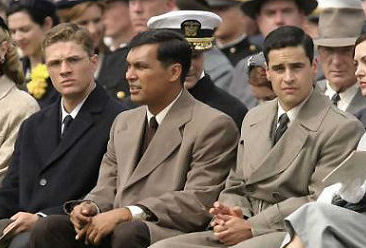Clint Eastwood‘s Flags of Our Fathers (Dreamamount, 10.20) has been seen on the Left Coast, and it’s “damn good,” according to a certain eyeballer. The word is that some kind of limited peek will be given to a select group within a few days. That doesn’t mean anyone’s necessarily going to write anything about it straight away. Let’s see how it plays out.

There’s a certain John Fordian echo in Flags of Our Fathers that I won’t explain but which I loved hearing about this morning. If the film has a primary focus, it’s about the battle between war legend and war reality — the space between the legend of battlefield heroism as promoted in political speeches and by war memorial statues, and the reality of what it actually is for the men who lay their lives on the line.
But the comment that really raised my eyebrows was a thought passed along to this witness from a voice in the Eastwood/Warner Bros. camp, to wit: as good and admirable as Fathers is, Letters From Iwo Jima — Eastwood’s lesser-budgeted film about the Japanese forces who fought the Americans on that volcanic island in early ’45, and which is acted entirely in Japanese — is “a better film.”
This is obviously just an opinion, just one guy talking, etc. But when you consider the persistent questions about whether Letters will in fact be released in December ’06 or sometime in January ’07, well….what are people thinking? Flags of Our Fathers and Letters From Iwo Jima are joined-at-the-hip movies — same war backdrop, same battle, same director, same color scheme. Some of the same incidents, according to Peter Bart‘s 9.3.06 Variety piece, are depicted in both.
How, given all this, can they not be considered as a single unified work? What person with any respect for what Eastwood has apparently constructed here would argue for Flags to be released on 10.20.06 and Letters to be released in January ’07, which would mean that the latter wouldn’t qualify as a ’06 Best Picture candi- date? Especially given that guy’s view that the Japanese film is the “better” work?

I reviewed Paul Haggis‘s Flags script last April — here’s a portion of what I wrote:
“Flags of Our Fathers is about the loneliness and apartness of young soldiers living in two worlds — the godawful battle-of-Iwo-Jima world where everything is ferocious and pure and absolute, and the confusing, lost-in-the-shuffle world of back home, where almost everything feels off and incomplete.
“There are many, many characters in Flags but it’s basically about three of the six young Marines who raised the American flag on a pole atop Mt. Surabachi during the Iwo Jima fighting in early 1945, resulting in a photo that was sent around the world and came to symbolize the valor of U.S. soldiers.
“Three of the flag-raisers died in battle soon after, but the three survivors — John Bradley (Ryan Phillipe), Ira Hayes (Adam Beach) and Rene Gagnon (Jesse Bradford ) — were sent home to take bows and raise funds and build morale on a big public relations tour arranged by the military.
“And the film — the script, I mean — is primarily about their vague feelings of alienation from their admirers and even, to some extent, their families. And vice versa.
“Heroes, a narrator says at the end, are something we need and create for ourselves. But the soldiers don’t get it or want it. They only feel for each other. They may have fought for their country, but they died for their friends.”









